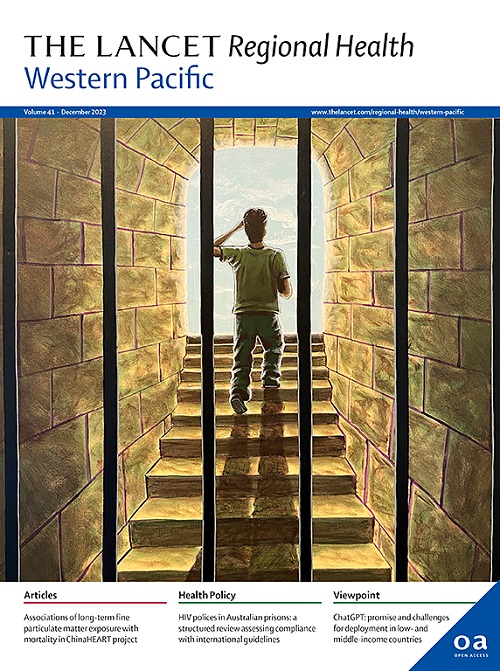维塞那肽作为二甲双胍附加疗法对 2 型糖尿病患者的疗效和安全性:一项随机、双盲、平行、安慰剂对照的 3 期研究
IF 8.1
1区 医学
Q1 HEALTH CARE SCIENCES & SERVICES
引用次数: 0
摘要
背景在已完成的两项2期研究中,每周注射一次的胰高血糖素样肽-1受体激动剂维塞那肽显示出有效的血糖控制和良好的耐受性,且无需剂量滴定。这项多中心 3 期临床研究包括 24 周随机、安慰剂对照、双盲期和 28 周开放标签延长治疗期。年龄≥18岁和≤75岁、糖化血红蛋白(HbA1c)≥7.0%和≤10.5%[≥53.0和≤91.27 mmol/mol]的患者(N = 620)按1:1的比例随机分配,在双盲期每周一次皮下注射维塞那肽150微克或安慰剂。随后,安慰剂组患者转为接受维塞庚那肽治疗(安慰剂→维塞庚那肽组),维塞庚那肽组患者在开放标签延长治疗期内继续接受同样的治疗。研究结果第24周时,维塞那肽的安慰剂调整后最小二乘法均值(LSM)变化为-0.57%(95% CI -0.71至-0.43)(p <0.001)。与安慰剂组相比,维塞那肽组达到 HbA1c <7.0%和≤6.5% [<53 和≤48 mmol/mol]的患者比例更高(115 [40.5%] vs 50 [17.9%];p <0.001;60 [21.1%] vs 17 [6.1%];p <0.001)。与安慰剂相比,维塞那肽可显著降低空腹血浆葡萄糖和餐后 2 小时血糖。在开放标签延长治疗期间,这些变量的改善趋势得以保持。在为期52周的研究期间,没有严重胃肠道不良事件或严重低血糖的报道。解释作为二甲双胍治疗的附加疗法,每周注射一次150微克的维培那肽可显著改善二甲双胍单药治疗控制不佳的中国T2DM患者的血糖控制,且耐受性良好。本文章由计算机程序翻译,如有差异,请以英文原文为准。
Efficacy and safety of visepegenatide as an add-on therapy to metformin in patients with type 2 diabetes: a randomised, double-blind, parallel, placebo-controlled, phase 3 study
Background
Visepegenatide, a once-weekly glucagon-like peptide-1 receptor agonist injection, demonstrated effective glycaemic control and good tolerability without the requirement of dose titration in the two completed phase 2 studies. We aimed to evaluate the efficacy and safety of visepegenatide in Chinese patients with type 2 diabetes mellitus (T2DM) inadequately controlled by metformin monotherapy in this phase 3 clinical study.
Methods
This multicentre phase 3 clinical study included a 24-week, randomised, placebo-controlled, double-blind period followed by a 28-week open-label extended treatment period. Patients (N = 620) aged ≥18 and ≤75 years with glycated haemoglobin (HbA1c) ≥7.0% and ≤10.5% [≥53.0 and ≤91.27 mmol/mol], were randomized in a 1:1 ratio to receive visepegenatide 150-μg or placebo once-weekly subcutaneous injection during the double-blind period. Subsequently, the patients in the placebo group were switched to visepegenatide treatment (placebo→visepegenatide group), and the patients in the visepegenatide group continued the same treatment during the open-label extended treatment period. The primary endpoint was the change in HbA1c from baseline to week 24.
Findings
At week 24, the placebo-adjusted least squares mean (LSM) change of HbA1c was −0.57% (95% CI −0.71 to −0.43) with visepegenatide (p < 0.001). The proportion of patients achieving HbA1c < 7.0% and ≤6.5% [<53 and ≤ 48 mmol/mol] was higher in the visepegenatide group versus the placebo group (115 [40.5%] vs 50 [17.9%]; p < 0.001, and 60 [21.1%] vs 17 [6.1%]; p < 0.001). Visepegenatide demonstrated a significant reduction in fasting plasma glucose and 2-h postprandial glucose compared with placebo. Trends in the improvement of these variables were maintained during the open-label extended treatment period. No severe gastrointestinal adverse event or severe hypoglycaemia was reported during the 52-week study period.
Interpretation
Once-weekly injection of visepegenatide 150 μg as an add-on treatment to metformin therapy significantly improved glycaemic control and was generally well tolerated in Chinese patients with T2DM who were inadequately controlled with metformin monotherapy.
Funding
The study was funded by PegBio Co., Ltd, Suzhou, China.
求助全文
通过发布文献求助,成功后即可免费获取论文全文。
去求助
来源期刊

The Lancet Regional Health: Western Pacific
Medicine-Pediatrics, Perinatology and Child Health
CiteScore
8.80
自引率
2.80%
发文量
305
审稿时长
11 weeks
期刊介绍:
The Lancet Regional Health – Western Pacific, a gold open access journal, is an integral part of The Lancet's global initiative advocating for healthcare quality and access worldwide. It aims to advance clinical practice and health policy in the Western Pacific region, contributing to enhanced health outcomes. The journal publishes high-quality original research shedding light on clinical practice and health policy in the region. It also includes reviews, commentaries, and opinion pieces covering diverse regional health topics, such as infectious diseases, non-communicable diseases, child and adolescent health, maternal and reproductive health, aging health, mental health, the health workforce and systems, and health policy.
 求助内容:
求助内容: 应助结果提醒方式:
应助结果提醒方式:


